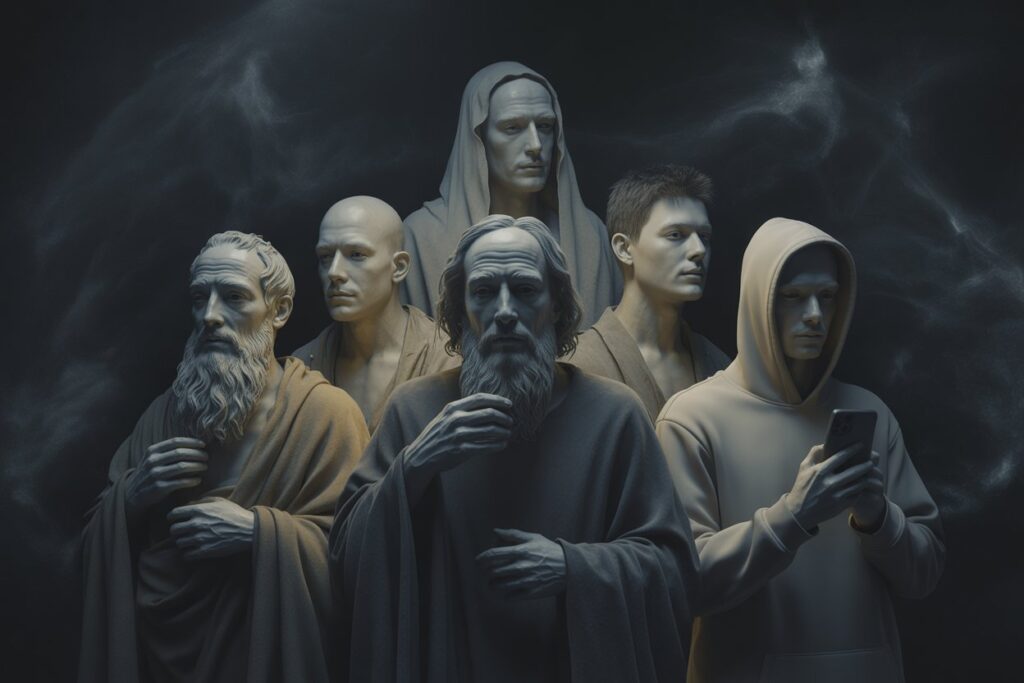Contents
Introduction: The Essence of the Archetype
The “holy fool” is not merely an eccentric madman or a jester, but a profound archetype with roots deep in ancient cultures. At its core, it represents a figure who deliberately rejects social norms, form, and convention in order to protect the true meaning of life, truth, or spirituality. The fool walks “against the form,” exposing lies and the substitution of substance with external rituals.
This archetype is paradoxical: society often rejects the fool, yet secretly respects him, because he touches something transcendent, inaccessible within the boundaries of “decency.”
Carl Gustav Jung might have called this the collective unconscious image of the “wise fool” — the one who reveals wisdom through apparent foolishness. In different cultures, the fool acts as a catalyst: he provokes, shocks, and reminds people of primordial truth. The concept “form kills meaning” fits perfectly here — the fool fights against this “murderous” form, whether it is social convention, political power, or dogma.

Ancient Roots: The Cynics of Greece
The archetype of the fool can already be traced back to antiquity. A classic example is Diogenes of Sinope (c. 412–323 BCE), founder of the Cynics. Diogenes lived in a barrel on the streets of Athens, rejecting material goods and social status. He scandalized society: walking around with a lantern in daylight searching for “an honest man,” masturbating in public to show the absurdity of shame, and responding to Alexander the Great — who blocked his sunlight — with the famous words: “Step aside, you’re blocking my sun.”
Here, foolishness was a tool of critique. Diogenes exposed the falseness of aristocracy and philosophical schools, showing that true freedom lies in simplicity and authenticity. Cynics (from the Greek “dog”) emphasized: form (wealth, power) kills meaning (natural life). This archetype influenced the Stoics and even early Christians — some call Diogenes a “prototype of the holy fool.”
Another case is Crates of Thebes, Diogenes’ student, who gave away all his property and lived as a beggar, preaching equality. In Greece, fools acted as “social mirrors,” forcing the elite to confront their own emptiness.
The Middle Ages: Court Jesters and Mystics
In Europe, the archetype evolved into the figure of the court jester. The fool (fool, jester) had the privilege of speaking the truth to the king — things others feared to say. In Shakespeare’s King Lear, the Fool is precisely a holy fool, who through humor and absurdity exposes the madness of the king. Jesters wore caps with bells, symbols of “stupidity,” yet their wit was often prophetic.
In the Islamic tradition, Sufi mystics embodied a similar archetype. Nasreddin Hodja (13th century) rode his donkey backwards, told absurd stories, but each one exposed the hypocrisy of clerics and rulers. Sufis used “madness” (majnun) to draw closer to the divine, bypassing rigid rituals. Here again, scandal served as a tool to protect meaning from “the power of form.”
The Russian Tradition: Holy Fools in Rus’
In Russia, foolishness blossomed in Orthodox culture from the 14th to the 17th centuries. Yurodivy (from “urod,” ugly, but in the sense of “not of this world”) were holy madmen who feigned insanity in order to prophesy and denounce. They walked barefoot in winter, wore rags, ate scraps — demonstratively rejecting form.
A classic example is Basil the Blessed (16th century, Moscow). He threw stones at the houses of the righteous (to “wake up demons”) and kissed the walls of sinners’ homes (to greet the angels). Basil rebuked Ivan the Terrible, predicting fires and wars. Society revered him: after his death he was buried by the Kremlin, and the cathedral was named after him.
Another is Procopius of Ustiug, who slept in the snow and foretold disasters. Holy fools in Rus’ were “the conscience of the people”: they exposed the lies of power and church when these became purely formal.
Remarkably, foolishness was institutionalized — the church canonized dozens of holy fools, recognizing their role in preserving spiritual meaning.
Modern Forms: Philosophical Fools of the 21st Century
In our time, the archetype has not disappeared, but transformed. Instead of barrels and rags, there are texts, videos, memes, and public performances. The project Deconstruction of Reality is itself an embodiment of this archetype.
Other examples:
- Comedians and satirists: George Carlin or Jon Stewart, who exposed politics and media through humor. Carlin said: “It’s a big club, and you ain’t in it” — pure holy foolishness, exposing falsity.
- Philosophers and activists: Slavoj Žižek with his provocative lectures, mixing pop culture with Hegelian thought to reveal the absurdity of capitalism. Or Edward Snowden, who “does not fit” into the system, but revealed the truth about surveillance.
- In popular culture: Characters like the Joker (especially Joaquin Phoenix’s version) embody the fool, fighting formal injustice through chaos.
- On the internet: Trolls and meme culture, where anonymous users scandalize in order to ridicule dogmas. Or figures like Elon Musk, who through tweets and memes provokes the elite, reminding them of “meaning” (space, AI) behind the form of business.
The paradox remains: society rejects such “fools” (bans them, criticizes them), yet respects them — their ideas change the world.
Conclusion: Why Is the Archetype Eternal?
The holy fool is the defender of meaning in a world dominated by form. From Diogenes in his barrel to the texts of Deconstruction of Reality — this is a line of continuity. In the age of social media and AI, foolishness evolves: now we have “digital holy fools” who expose algorithms and fake narratives through content. If “form kills meaning,” then the fool is the antidote, reminding us of living truth.